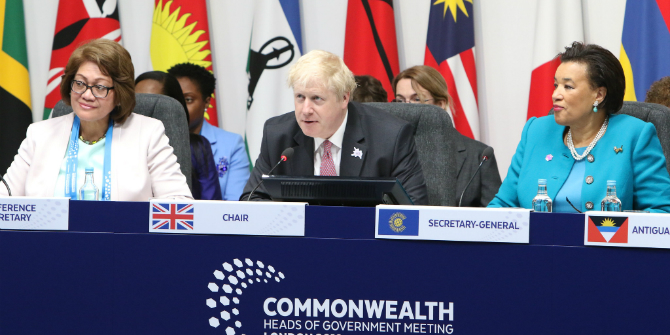 Since the Brexit vote, EU media policy has a new sense of urgency. It remains to be seen if member states will be more prepared to deepen media policy convergence in an attempt to protect fundamental values and rights, writes Damian Tambini.
Since the Brexit vote, EU media policy has a new sense of urgency. It remains to be seen if member states will be more prepared to deepen media policy convergence in an attempt to protect fundamental values and rights, writes Damian Tambini.
In late 2016 DG Justice held a joint colloquium with DG CONNECT, discussing current challenges to media pluralism and media freedom, it focused on two key challenges to European media systems:
- Technological change that undermines sustainability of public interest media and the existing regulatory settlement. In 2015, the UK ad revenue of Google was greater than that of the entire UK newspaper industry. In the UK, the share of newspaper ad revenue has declined from around 40% of total ad revenue in 1985 to around 10% of all ad revenue. Display advertising is no longer an effective way of funding quality journalism. Audiences are also shifting away to an extent from television and public service media (PSM).
- The populist challenge of Brexit and Trump, recent attacks on independent media in Hungary, Poland and elsewhere in the EU and on its borders. In a less consensual, enemy-oriented political environment, in which media influence on opinion is crucial, populist politicians successful in seizing power have proven to be ready to challenge the established rules of the game in order to put pressure on the media. The populist surge is also – as I have pointed out – based on direct and deliberate exploitation of media change. Verification is no longer a passport to mass distribution. Emotion, exaggeration and spectacle rule.
The European media governance framework was designed in the post-war period with the need to avoid populist demagoguery in mind. It is time to test it, but the key question I would like to raise is whether this framework will facilitate the necessary modernisation of the European approach to media systems: a mixed commercial and publicly owned system with a strong public service element. Member states need to adapt, and the EU framework could be both a help and a hindrance.
The governance framework for media in EU member states is hugely complex. It is important to note that from a fundamental rights perspective we have not relied on an entirely free marketplace for ideas. Against JS Mill, we have not assumed that truth will always out; we have tended to try to tip the balance in its favour by careful design of media institutions.
This included ethical codes, broadcast licensing and media laws such as defamation that reward truth-seeking and responsible journalism. It includes fiscal policy and various forms of subsidy that support public interest media. These institutions can of course also constitute a minefield of opaque institutional relationships between states and media that are sites of corruption.
Facebook and other tech companies that function as intermediaries between information and its audience simply exist outside of this settlement because they are shielded from liability. The settlement for internet intermediaries, it could be argued, incentivises irresponsibility, since liability follows knowledge. Yet their sheer power and influence raise wider issues they cannot avoid.
 Image by shankar Dayal(9716701677), (CC BY 3.0).
Image by shankar Dayal(9716701677), (CC BY 3.0).
What are the threats to public service media and national regulatory authorities?
The superficial answer in both cases is pretty obvious: appointments, funding, and legal separation. Unfortunately, in practice, the threats are often less visible. Pressure can be brought to bear on both private and public media and their regulators informally through a wide range of policy shifts, from competition to spectrum to fiscal policy. Regulatory design, particularly that constrained by the limited EU competence in this area, can only achieve so much. Ultimately, only informed citizens choosing independent media can deal with the pressures on independent media.
That is why the AVMS proposals to introduce a clear definition of regulatory independence are hugely welcome and will make a real difference as the start of the process, but they are not sufficient by themselves.
The European framework can also constrain action. It is still a live question whether PSM will survive the transition to digital: the indirect subsidy of spectrum is declining in value and ad revenue is falling. It may be that more radical interventions will be necessary. Will member states have sufficient room for manoeuvre to promote the ‘findability’ of public service content, public interest journalism, prominence and funding? At what point does the attempt to regulate new platforms to promote prominence of public interest journalism constitute a restriction of the freedom of these platforms?
What can be done?
- Actively facilitate more monitoring, and exchanges of best practices. Work done by European Commission funded research centres at the European University Institute in Florence and the Media Foundations of Sparkasse in Leipzig is laying a foundation, but much more needs to be done in terms of monitoring of media independence and independence of regulators.
- We also need to get beyond a knee-jerk response to standard setting. As Onora O’Neil and Judith Lichtenberg made clear some time ago, press and media freedom are distinct from freedom of expression. They are institutional (not human) rights and instrumental – i.e. they exist to the extent that the media serve democracy. It is necessary to define not only the rights but also the responsibilities of these institutions, and reject a negative rights version of ‘press freedom’.
- This is a long process, but at some point it will be necessary to reopen the question of intermediary liability with a view to a sliding scale of responsibilities that apply to size and scale. Respondents to the public consultation said that ethics and self-regulation are needed in the new media environment. But we need also to think about what incentives will be needed to ensure that self-regulation occurs.
- The crucial importance of independence of audio-visual regulators must be recognised, and the potential for them to be given the tools and the data to monitor new media. The independence of these agencies has never been more crucial in democratic countries, for the very simple reason that the media have never been so important to democracy.
- We need to promote transparency: both of ownership – by implementing the Access Info recommendations – but also of all funding and relationships between state and media such as advertising by the state. This could potentially be delivered through state aids rules.
Democratic institutions of Europe will be tested in coming years, and the media may be a weak point. We are witnessing a crisis of democratic legitimacy, and the notion that there may be opaque reciprocities between those who rule and those who make meaning is the very apex of that loss of trust.
In addition to ensuring that member states have the ability to respond to the challenges whilst protecting fundamental rights, I would argue that the EU does need to act on the media. In the area of funding and regulation, they may need to take radical action. To facilitate this we need to communicate one key principle, which is the separation of media and the state. This separation must be as fundamental as the separation of church and state.
This is an extract from Damian Tambini’s Keynote speech to the colloquium. It first appeared on Media Policy Project blog.
This post gives the views of the author and does not represent the position of the LSE Brexit, nor of the London School of Economics and Political Science.







Firstly this is a great read, especially as this covers some areas that most people including myself were not aware of. The complexity of the governance framework for media companies within the EU does seem like a bottomless pit of unknowns. Most especially the protection of both data, media and of course the individual and company rights. I believe as with most things Brexit related, we will all have a very lengthy learning curve, with financial implications that are good and bad. Lets just hope that the EU allows us to adjust to the new frameworks that they pretty much dictate at present.